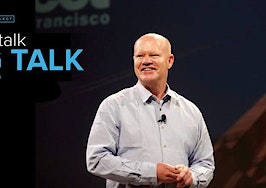- To prevent getting overwhelmed before you’ve even gotten started, work forward, not back.
- Don’t try to do it all at once. Take things in order to keep it simple.
- Most everyone is already at least partly up to speed on today’s three steps, so you’re probably not starting at zero!
Last week, we talked about some of the reasons to go paperless. Today, we’ll look at the first few steps to getting there.
The idea is to give you a workable sequence of steps that can get you there, along with some of the tools you’ll need.
Don’t get overwhelmed!
Maybe the most common impediment to going paperless is that we feel overwhelmed by the idea of trying to deal with all the things we already have on paper.
It’s just too big a job. You don’t know where to put all these docs and files and notes and lists, digitally. You have a system that makes sense, and you’ll lose that if you get rid of all this paper.
It’s your security blanket — the thought of throwing away those files and other things, no matter how you’ve stored them digitally, is terrifying.
Here’s the secret to getting started: Don’t worry about all the paper you already have. You can deal with that later.
You’ll get started much more easily by looking forward rather than back.
So first, let’s stop generating new paper. Once you begin to work without paper, you’ll find it very easy to live without paper, and you’ll actually become eager to get rid of it.
The good news is, if you’ve already mastered today’s three steps, you’re ahead of the game — and if you haven’t, they’ll get you off to a quick start.
Here are the first steps.
Transaction management
If your transactions aren’t already wholly paperless, that’s the place to start.
It’s crucial that you master a digital transaction management system. If your broker doesn’t provide one, popular solutions include DocuSign, zipForm, dotloop and SkySlope.
Alternatively, since you’re going to be using a cloud storage app (such as Dropbox or Google Drive) as part of your paperless system, you could store transaction docs there and use something like Adobe Acrobat for electronic signatures and get through your transactions paperlessly that way.
Because there are numerous options, this isn’t the place to go in-depth about using a transaction management system. They all have somewhat different architectures and capabilities. But the important thing is that all of them will allow you to work your way through a deal from beginning to end without using paper.
If you need help, there are resources available to get you up to speed. But it’ll be up to you to commit to becoming expert in using those tools.
Until you do, don’t worry about the next steps to going paperless; this part has to be in the bag before you proceed.
Calendars
If you’re functioning paperlessly within your transactions, the next thing to tackle is your calendar. I understand this part can be trickier than it sounds! There are plenty of people who still use paper calendars, feeling they’re easier to deal with. But there are better ways.
There are lots of options for electronic calendars.
The easiest and cheapest solution is probably Google Calendar, which is free. It’s the most popular platform, so it’s ubiquitous; it syncs with all kinds of other things (including other calendars, smart devices and so on) and it’s easy to use.
It’s handier than that old paper calendar because it’s in your phone and available on any other electronic device that’s connected to the internet, so you’re literally never without it and can’t lose it.
It provides the advantage of allowing you to set up multiple calendars (work, personal and so on) and view them a number of different ways, as well as share them with family, clients and coworkers.
And you can send and receive events via email, easily enter recurring events, and do much more that you could never do on paper.
Power tip: On the Google Calendar app on your phone, try the “schedule” view — this just shows your appointments for the day, in list form, with start times.
To-do lists
I don’t know about you, but when I kept track of my to-dos on paper, I often had notes jotted in multiple places, many of them regarding things that demanded urgent attention and that I couldn’t afford to drop the ball on.
This is living on the edge, and it can get hairy.
The beauty of the electronic to-do list is that, like the calendar, it’s everywhere, including your phone and any other device connected to a network. You simply can’t lose anything or end up with different notes in different places.
It also gives you options to schedule tasks or to have them simply be on a list with no due date, to “roll over” things that didn’t get done, to upload files or connect with emails and more. When you check an item as complete, it will disappear from the list, but still be found in an archive.
I’ve been using Todoist, which is a free app with premium upgrades available. It’s simple, and it allows you to organize things a number of different ways.
Another popular app is Wunderlist (also free with a premium option). This has been acquired by Microsoft and has some interesting and potentially valuable integration with Outlook.
There’s also Workflowy and Any.do, Asana (which is designed for teams) and others. Because they’re free, it’s easy to download the apps and try them out, and you can even use them alongside your old paper lists while you get comfortable with one of them.
Once you enter your to-dos into one of these apps, your days of written to-do lists will be numbered — they just work so much better.
If you’re not totally up to speed yet with a digital transaction management system, I encourage you to focus exclusively on that, until you are able to navigate an entire transaction within one (including scanning any stray paper docs that may come your way into it, so you finish the transaction with no paper on file at all).
Once that’s working, if your calendars and/or to-do lists are still on paper, in just a week or so you can successfully migrate to electronic versions of both of those.
When you’ve stopped using paper for your transactions, calendars and to-do lists, you’ll have taken a big step toward paperlessness.
Next time around, we’ll explore ways to effectively use a note-taking app and dig deeper into how we can really function — and function better — without using any paper at all. See you then.
Brian Walker manages a top-producing Indianapolis branch office for Indiana’s largest independent real estate firm, the F. C. Tucker Company. Connect with him on LinkedIn.











